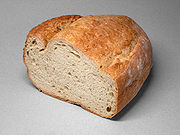A portugese research group found hexavalent chromium in white and whole bread samples.
Background:
Chromium is a controversial element with important biological characteristics, depending on its different species. While chromium is considered essential in its trivalent form, the hexavalent species is classified as genotoxic and carcinogenic. Unfortunately, hexavalent chromium compounds have a large application in industry, and soils and sediments can become contaminated with this species.
The global commercialization of food products and the increasing pollution of all environmental compartments, especially in some countries, can contribute to the contamination of grains with some pollutant compounds, including toxic metals. Depending on the species and genetic strains, vegetables can accumulate metals in their edible tissues, constituting the main vehicle of the ingested toxic metals.

Bread is a major constituent of the human diet and a significant source of minerals including chromium. Not known up-to-know is, whether chromium in bread is present to any extend in its toxic hexavalent form.
Photo: French white bread
The new study:
The portugese research group headed by
Maria de Lourdes Bastos from the
University of Porto analysed 152 samples of both white and whole bread for total and hexavalent chromium. For this purpose they developed and validated a method including a wet acid digestion procedure for total chromium dissolution, a selective alkaline extraction of hexavalent chromium, and ETAAS determination. The total chromium content found was with 47.3 +- 20.0 and 50.9 +- 22.2 μg/kg of dry weight for white and whole very similar for both types of bread. The hexavalent chromium content of both types of bread was about 12-13 % of the total chromium.
Based on these results, the researchers concluded, that bread can contribute about 4-10 % of the Reference Daily Intake of total chromium (120 µg/day) but also leads to an intake of nearly 2 µg of the toxic Cr(VI) per day.
Comment:
The principal challenge of this study consisted in the selective quantification of the relatively low levels of hexavalent chromium (12 %) in the presence of relatively high levels of trivalent chromium, the predominant species of the metal in bread (88%). Since the identification of species in this work is operationally defined, the pretreatment of the samples should guarantee the quantitative separation of hexavalent chromium, avoiding the alteration of its oxidation state. A severe limitation of the reported method was the quantification limit for hexavalent chromium in bread of 5.6 µg/kg, very close to the found concentration of 5.65 and 6.82 µg/kg for white and whole bread, respectively. Such result very close to the quantification limit of the presented method call for a verification by a more sensitive method for chromium speciation analysis.
Michael Sperling
 The original publication
The original publication
Maria Elisa Soares, Elsa Vieira, Maria de Lourdes Bastos,
Chromium Speciation Analysis in Bread Samples, J. Agri. Food Chem., 58/2 (2009) 1366-1370.
DOI: 10.1021/jf903118v Related studies
Related studies
Abayneh A. Ambushe, Robert I. McCrindle, Cheryl M. E. McCrindle,
Speciation of chromium in cow's milk by solid-phase extraction/dynamic reaction cell inductively coupled plasma mass spectrometry (DRC-ICP-MS), J. Anal. At. Spectrom., 24/4 (2009) 502-507.
DOI: 10.1039/b819962k
Róbert Kovács, Aron Béni, Roland Karosi, Csilla Sógor, József Posta, Investigation of chromium content in foodstuffs and nutrition supplements by GFAAS and determination of changing Cr(III) to Cr(VI) during baking and toasting bread, Food Chem., 105/3 (2007) 1209-1213.
DOI: 10.1016/j.foodchem.2007.02.030
C. Cabrera-Vique,
Chromium presence in foods and beverages: a review,
FoodInfo Online Features, 2005

Maria E. Soares, Maria L. Bastos, Margarida Ferreira,
Selective Determination of Chromium (VI) in Powdered Milk Infant Formulas by Electrothermal Atomization Atomic Absorption Spectrometry after Ion Exchange,
J. AOAC International, 83/1 (2000) 220-223.

J. Lameiras, M.E. Soares, M.L. Bastos, M. Ferreira,
Quantification of total chromium and hexavalent chromium in UHT milk by ETAAS, Analyst (London), 123/10 (1998) 2091-2095.
DOI: 10.1039/a804700f
A. Zayed, C.M. Lytle, J.H. Qian, N. Terry,
Chromium accumulation, translocation and chemical speciation in vegetable crops, Planta, 206/2 (1998) 293-299.
DOI: 10.1007/s004250050403
 Related EVISA Resources
Related EVISA Resources Link database: Toxicity of Chromium species
Link database: Toxicity of Chromium species Link database: Industrial Use of Chromium
Link database: Industrial Use of Chromium Related EVISA News
Related EVISA News
last time modified: November 8, 2025